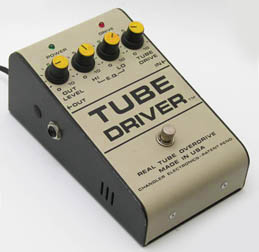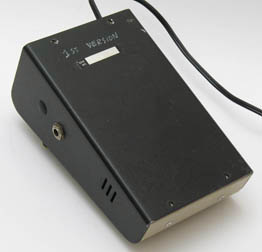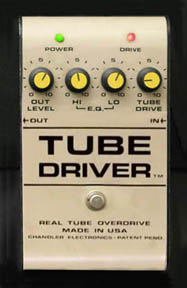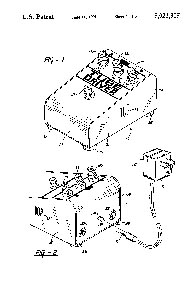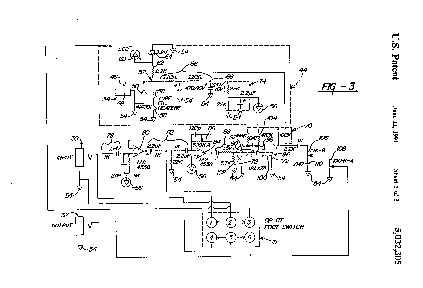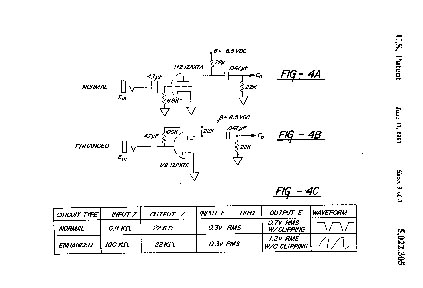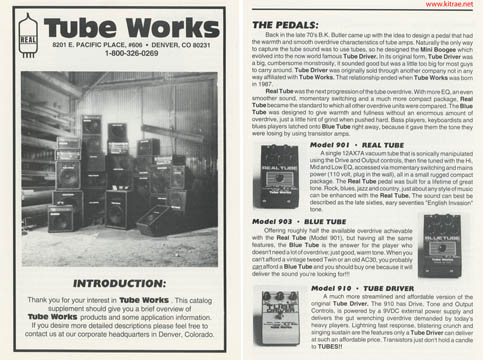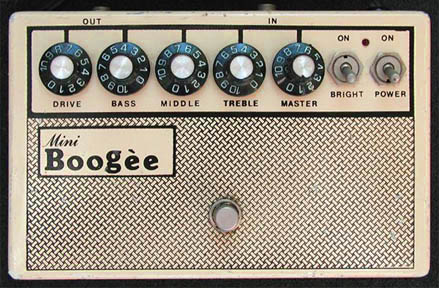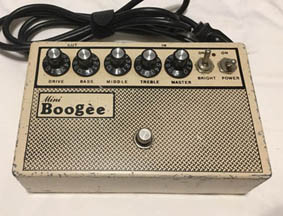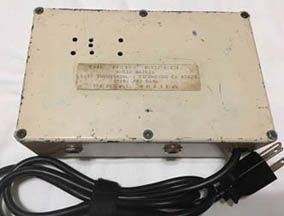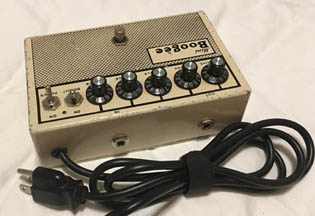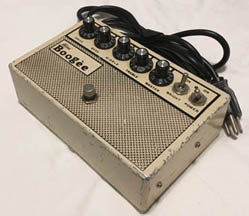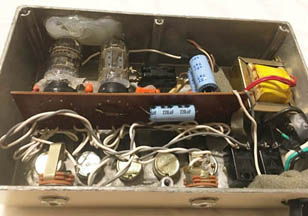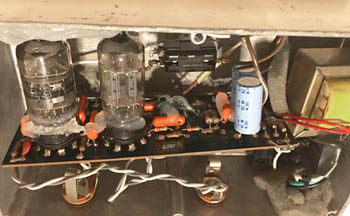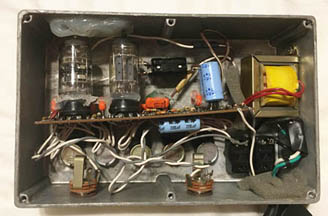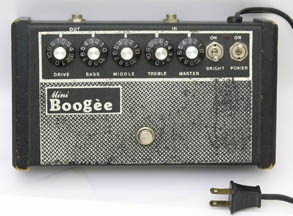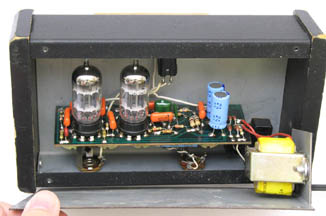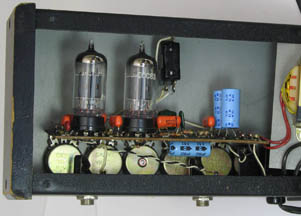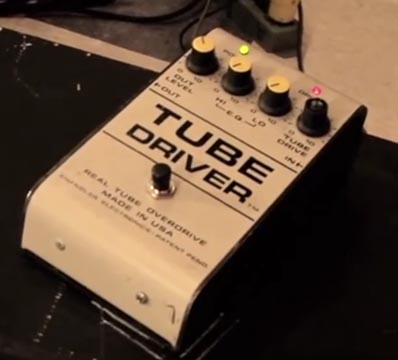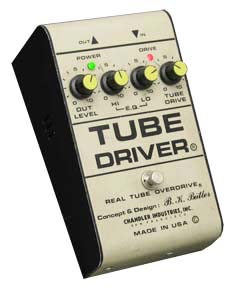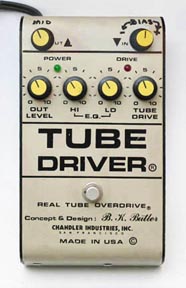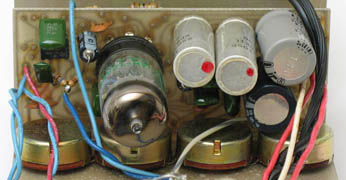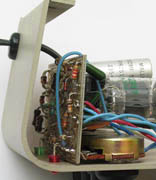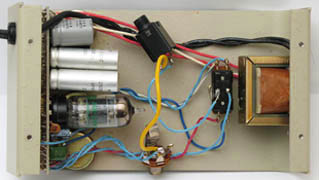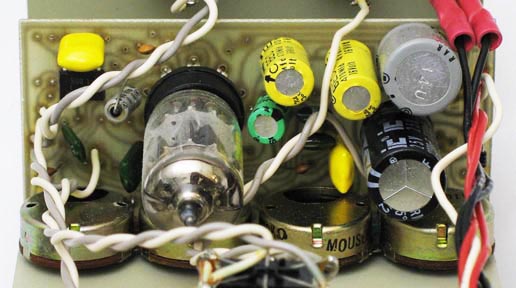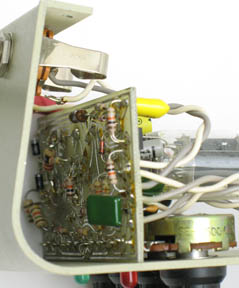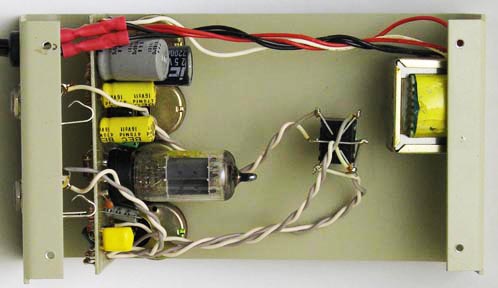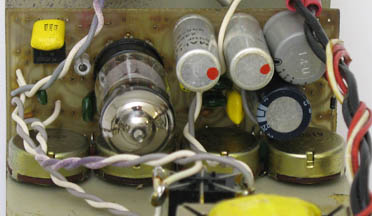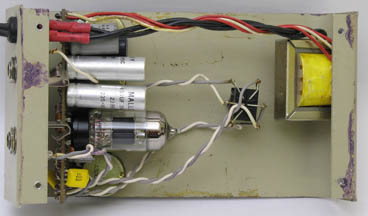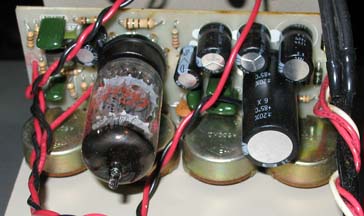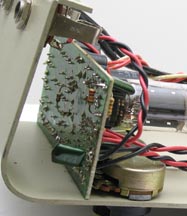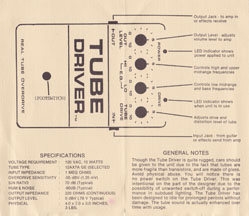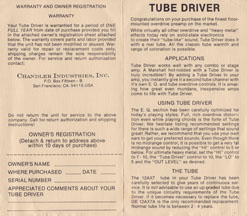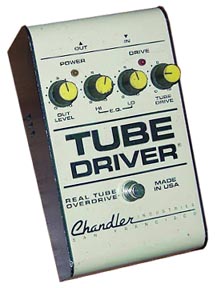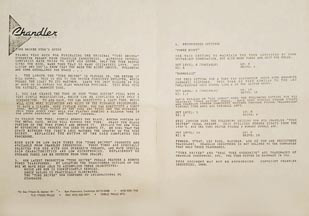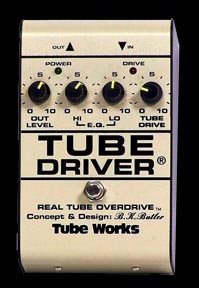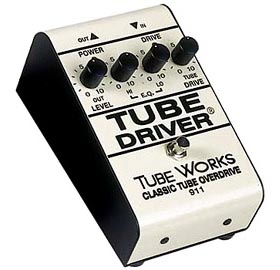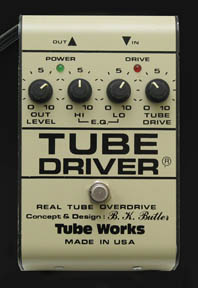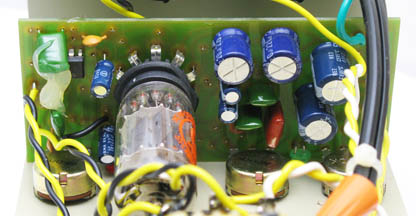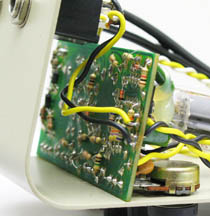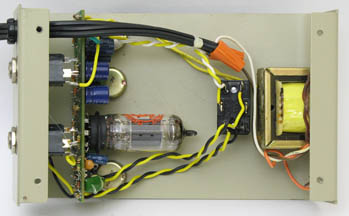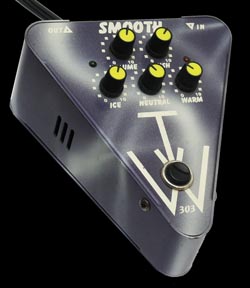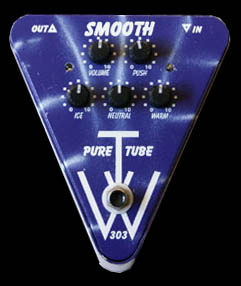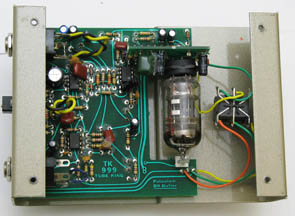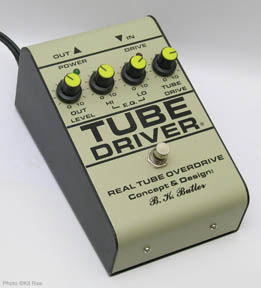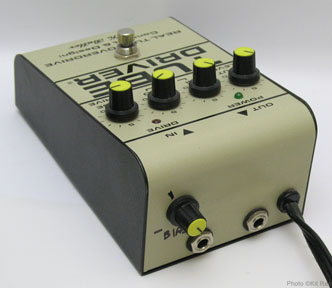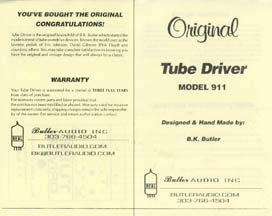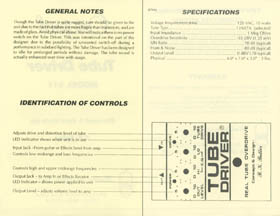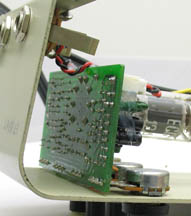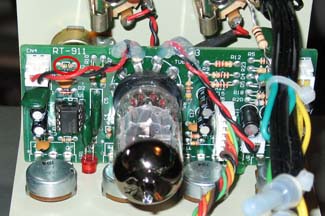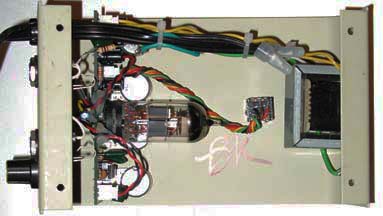Kitís Secret Guitar, Gear, and Music Page
Guitar stuff, gear stuff, soundclips, videos, Gilmour/Pink Floyd stuff, photos and other goodies.
Copyright Kit Rae.
VISIT MY SWORDS, KNIVES and FANTASY ART WEBSITE www.kitrae.net
Article written in 2015. Last update August 2020
For the main Tube Driver article CLICK HERE
For the David Gilmour Tube Driver article CLICK HERE
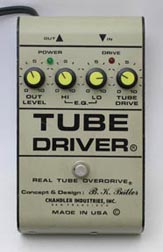
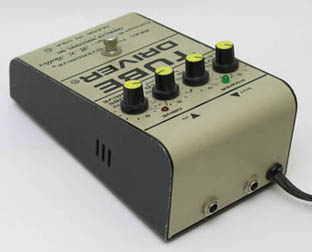
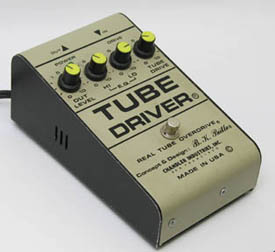
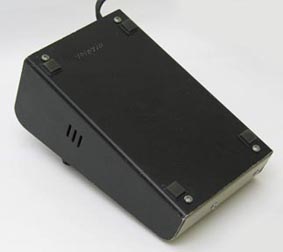
The Tube Driver was one of the first tube overdrives to enter the effects pedal market in the late 1970s. It became a very popular pedal among guitarists for the next 35 years, and onwards. Inspired by the Hammond organ sound of the band Deep Purple in the 1970s, the genesis of the Tube Driver happened when Brent K. Butler wanted to overdrive his keyboard by modifying the tube amplification circuit of an old stereo record player. He mounted the circuit in a Radio Shack enclosure and let a few local guitarists try it out. The positive response led Butler to further reduce and simplify the circuit, making an early version of his Tube Driver pedal for friends around 1975.
After getting some practical work experience in electronics working for Carvin amplification, Butler refined the Tube Driver even more. He first marketed and sold them publicly in 1979, under the Butronics brand. They were housed in a blue metal box with 3 knobs and a 6AV6 or 12AV6 tube inside. He then made a 5-knob version called the Mini Boogee in 1980, sold through his Audio Matrix business that he ran out of Carvin's old building. He later changed the name to Mini Matrix after getting a cease and desist from Mesa Engineering, who owned the name Mesa Boogie. The Mini Boogee/Mini Matrix circuit included two 12AX7 preamp tubes. Butler then reworked the design again, combining an op-amp (operational amplifier or integrated circuit chip) and a pre amp tube running on starved voltage to generate the distortion, which led to the popular 4 knob Tube Driver. Butler says he designed that version in 1983 and it was produced in 1985.
A rare original 1986 B.K. Butler/Chandler Tube Driver with TM after DRIVER and no B.K. Butler markings. Note the inout/output jacks are on the sides, rather than the end as on later models.
A rare 1985 Butler/Chandler Tube Driver (left) and 1987 Butler/Chandler Tube Driver (right)
Butler had trusted Chandler Industries to distribute some of his first tube pedals, the Mini Boogie/Mini Matrix, so he again used them for his new Tube Driver distribution in 1985. This was before Butler was actually marking pedals with his own name, so those first Tube Drivers were marked TUBE DRIVER™ and CHANDLER ELECTRONICS-PATENT PEND on the front, with LEDs placed above the the screen printed text. Butler decided he needed his name marked on the pedal. The second version was made with the LEDs moved below the text and were marked TUBE DRIVER®, Concept & Design: B.K. Butler, with CHANDLER INDUSTRIES, INC at the bottom. In 1986, when he was still working for Dean Markely, Butler updated his tube overdrive design and added midrange knob. By 1987 he had resigned from Dean Markley and founded the Tube Works brand in Denver, Colorado. Some of his first TW products were the 5-knob Real Tube overdrive (TW-901) and Blue Tube Enhancer (TW-903, a lower gain version for blues players). These were essentially improved, 5 knob versions of the Tube Driver circuit under his own company name.
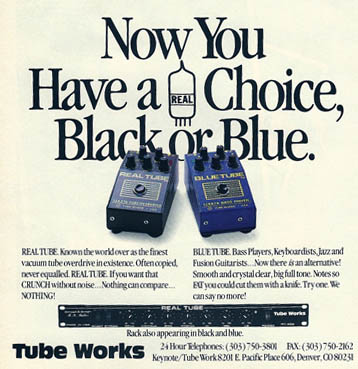
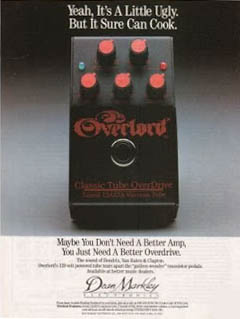
A Tube Works magazine ad from the late 1980s, and the Dean Markley Overlord, which was a knockoff of the Tube Works Real Tube pedal
Butler ended his relationship with Chandler Industries in 1987, but unfortunately Chandler had trademarked the name Tube Driver and Real Tube Overdrive the same year. They went on to have an inaccurate copy of the Tube Driver made around 1988. Then Butler's former employer, Dean Markley, made an exact clone of Butler's 5 knob Real Tube in 1988 called the Overlord. After this, Butler decided to file for a patent protection on his circuit in 1989. The Chandler copies were marked with a Chandler script logo at the bottom, and removed Butler's name. Chandler then tried to stop Butler from making his Tube Drivers and Real Tubes pedals, claiming it was their circuit design and trademark. According to Butler, Chandler sued him in court, but he won in the end and retained what was his design from the beginning. Many people generally refer to all Tube Drivers as a "Chandler Tube Driver" because of that brief period when Chandler handled distribution and sold thier copy version version.
THE TUBE DRIVER CIRCUIT - The Tube Driver has a somewhat unique design compared to other vaccuum tube-based overdrives. It is totally different to how preamp tubes perform in a typical high voltage circuit. The power supply was also different. Rather than using an external power supply transformer like modern pedals, an internal step down transformer reduced the line voltage down to +-15 volts DC.
The input jack signal goes to 1/2 of the op-amp first, acting as a low impedance input buffer. It then it goes to the other half of the op-amp, acting as an inverting gain stage. The op-amp is set with a high gain to produce signal clipping, with the gain level controlled by the drive pot for a maximum around 350. This is where the primary distortion is generated before signal goes to the pair of triodes in the 12AX7 vaccum tube stage. It passes through a resistive divider into 1/2 of the inverting tube gain stage, then through another resistive divider before going into the second inverting gain stage of the tube. Rather than generating distortion, the vacuum tube applies its unique characteristics to color the distortion. At low drive settings the op-amp is not compressing or clipping the signal very much, which allows more transients to flow through and be compressed by the tube. At higher drive setting the op-amp is greatly compressing and clipping the signal going into the tube, so the tube has little effect. The standard negative voltage grid bias along with a negative 12 volts applied to the cathodes helps the tube exaggerate the distortion in a unique way. The tube requires two different voltages - one for the heating element and one for the amplifying elements. 12AX7 tubes typically get 150-300 volts in a high voltage circuit. The Tube Driver runs in "starved plate" mode, so the plate voltage is only around around 30 volts.
The original Butler patent # 5022305 from 1989 - "Tube overdrive pedal operable using low voltage DC battery eliminator"
The signal then travels through a standard Fender /Marshall/Vox-style passive tone circuit, with bass and treble controls, and a fixed resistor for the mid range (a mid range pot was a custom option). There is no active boosting of any frequencies. The bass or treble are cut flat at the zero knob position and at maximum on 10. The signal then goes to the volume pot and bypass footswitch. It is phase inverted at the output where it hangs with a high impedance load. Even though the tube stage of the circuit does not generate much high gain distortion clipping, the distortion created by the Tube Driver is very similar to the high gain, tube driven Marshall amp lead tone. It can also be dialed down to a light, Fenderish tube overdrive for blues or rhythm sounds.
Butler's Tube Driver circuit patent was granted in 1991 (Patent number: 5022305 Tube overdrive pedal operable using low voltage DC battery eliminator), and Chandler's ownership of the Tube Driver trademark was abandoned in 1993, so around 1993-94 Butler began making 4 knob Tube Drivers again under his Tube Works brand. Following the Tube Works product numbering, he named this version model 911, after his favorite car, the Porche 911. Butler also sold his Pure Tube/Real Tube circuit design to other companies who marketed it under their own brands, like the Ibanez Tube King TK-999, which was originally made by Tube Works. Butler sold his Tube Works company to Genz Benz in the 1990s and production moved to Taiwan. Genz Benz discontinued Tube Works in the 2000s. There were numerous other versions of the TD designed by Butler in the 1980-1990s, including rack mount variants (Tube Works, BKB/Chandler branded, and Chandler branded) and guitar amplifier versions. Around 2005 Butler started making the original four knob 911 Tube Driver again through his Butler Audio company, although only by custom order. Long time users David Gilmour and Eric Johnson were among the first working musicians to get some of these new model Tube Drivers.
Pages from a mid 1990s Tube Works catalog featuring the 901, 902 and 903 Tube Driver pedals
Below are some (by no means all) of the various versions of the Tube Driver that have been made since 1979. There were many, including several knockoffs. Case designs, colors, and graphics for each changed over time. This is as accurate as I can get in dating the versions, based on info from B.K. Butler and other sources, but any additional dating information is welcome.

201 Tube Driver (Butronics) - 3 knobs, blue Bud box aluminum enclosure. The earliest Tube Driver, hand made by BK Butler in Escondido, California, circa 1979-1980. Very high gain with built in compression. Used a low gain 6AV6 or 12AV6 tube for distortion and transistor stage for compression.
204 Tube Driver (Butronics) - 3 knobs, blue Bud box aluminum enclosure. Hand made by BK Butler in Escondido, California, circa 1979-1981. Very high gain with built in compression. The Sustain pot controls the built in compression, Drive is the distortion level, and Gain is the volume level. There is no EQ control.
The first version of the Mini Boogee in the cast metal enclosure
The third version of the Mini Boogee in the folded metal enclosure with imitation wood end caps
Mini Boogee B81 and Mini Matrix (Audio Matrix) - Designed and built by Butler under his Audio Matrix brand (1980-1984) in Escondido, California. An early incarnation of the 5 knob Tube Driver, with two preamp tubes. No op-amps. The layout and graphics were designed to make it look like a mini amplifier, even including a bright switch. They were designed to have a similar to the look of Mesa/Boogie combo amps in the bone white and black cabinets of the time. The power transformer was built internally, as on later Tube Driver models. There were several versions of the enclosure:
• the first version was in a bone white cast metal colored enclosure, labeled Mini Boogee with black printing, circa 1980
• the second version added fake wood panels to the ends, circa 1980
• the third version was changed to a sheet metal enclosure with black with white printing and included the fake wood paneling on the ends, circa 1981
• the fourth version was identical to the third, but the name was changed to Mini Matrix, circa 1981
Slight changes to the circuit and pcb layout were made throughout production. Randall Smith of Mesa Engineering sent a cease and desist to Butler in 1981 demanding he stop using the name Boogee, since that was too close to the name Smith was using for his Boogie amps. Butler changed the name to Mini Matrix, creating a third version of the black enclosure. It was sold until 1984.
(left to right) A rare original 1985 B.K. Butler Tube Driver with TM after DRIVER and no B.K. Butler mark, Eric Johnson's original Tube Driver, the common second version with the ® after DRIVER and Butler's name added, and a 1987 Tube Driver with mids and bias pots added as a custom option.
1985-86 circuit board, marked 9 3151 on the back side. Both sides of pcb are a tan colored. Resistors are soldered on the back side, capacitors and other components on the front.
Two 1987 circuit boards, marked 9 3151•Z on the back side. Both sides of pcb are a tan colored. Resistors are soldered on the back side, capacitors and other components on the front.
A 1987 circuit board made for Butler by a California firm. Traceack side was usually dark green, with no ID labeling. Most components were soldered on the front, but a few caps and resistors were soldered on the back.
Tube Driver / Real Tube Overdrive (BK Butler / Chandler) - The original, classic 4 knob Tube Driver with the iconic case color and graphics, made circa 1985 to 1987. I have never seen one dated earlier than 1985, but Butler said he first designed this version in 1983. He used an op amp stage to create the overdrive/distortion, which was followed by a 12AX7 pre amp tube stage to filter the sound. This version is commonly referred to by users as the "Chandler Tube Driver", although "BK Butler/Chandler Tube Driver" is more accurate, since there was also a knockoff made by Chandler without Butler's name or involvement. Butler insists that there never was a "Chandler" Tube Driver, that they just handled the marketing and distribution, but since the first version was ONLY branded with the Chandler name, and the revised graphics had Chandler's name under Butler's, the nickname is understandable.
Some of these early Tube Drivers were offered with a mid range knob or tube bias knob as a custom option. The bias pot allowed the gain of the tube to be altered by adjusting the voltage on the cathodes of the tube, simulating the effect of using higher or lower gain tubes. There were several different versions of the circuit, each with minor differences. The Level, Hi, Lo, and Drive pots are typically audio taper, but values vary. Most units have 100K audio for the Level and Lo pots and 500k audio for the Hi and Drive pots. Some have 1MΩ, Hi and Drive pots, or mixed 500k and 1MΩ Hi and Drive. The 1MΩ drive pots have about 2x the gain when the pot is at maximum as the 500k pots, and the larger pot also changes the tone stack frequencies.
Op amps were usually MC4558, but some have MC1458 or TLO72. There were some capacitor and resistor value differences from unit to unit as well. There was a standard 120VAC version made for the US market and a 240VAC export version. Tube Drivers with serial numbers up to #70 used EI transformers with 120VAC primaries/24VAC secondaries, and a center tap. It was full wave rectified into 12VDC to work with the circuit. After serial #70, to save on cost the EI Transformers were changed to 120VAC primaries/12V secondaries, no center tap. Those were half wave rectified into 12VDC.
Shown Above - Original TUBE DRIVER manual from 1987 (thanks to Tom for the scan)
There were three versions made by Butler from 1985-87. The first version was manufactured by Butler himself in his garage shop and marketed/distributed by Chandler Industries in the USA in 1985-86. It had the LEDs placed above the screen printed text and was marked on top:
TUBE DRIVER™
REAL TUBE OVERDRIVE
MADE IN USA
CHANDLER INDUSTRIES-PATENT PEND.
The input/output jacks were mounted on the rear end of the enclosure on some, and on sides of the enclosure on others. These are extremely rare as only about 200 of them were made, and approximately 50-100 of those were made with the jacks mounted on the sides, according to Butler. The pcb was tan colored with the marking 9 3151 on the trace side. Components were mounted on both sides. Eric Johnson used one on his 1986 album Tones, and has been a user ever since.
The jacks were later permanently moved to the the rear end and the graphics were modifed so the LED's were moved below the text. The front markings also changed but I have only ever seen one example like this:
TUBE DRIVER®
REAL TUBE OVERDRIVE
CHANDLER NDUSTRIES, INC.
SAN FRANCISCO
MADE IN USA ©
Butler trusted Chandler in the beginning, but later decided he needed his name on the pedal. He made a revised version in 1986-87 identical to the one above, but the front markings were changed to:
TUBE DRIVER®
REAL TUBE OVERDRIVE
Concept & Design: B.K. Butler
CHANDLER INDUSTRIES, INC.
SAN FRANCISCO
MADE IN USA ©
Approximately 100-150 of those were made using tan colored pcbs with a slightly different trace pattern that the previous pcb. They were marked 9 3151•Z on the trace side. Components were mounted on both sides. I have seen two slightly different sets of component values on that board. On a few that I have owned there was no volume until the Drive pot was dialed above 2. The sound also seems to vary greatly from one pedal to another. Some sound the same as next version, some different. Part of this could simply be due to part values drifting due to component aging.
Various B.K. Butler Tube Driver circuits - 1985 circuit on left, 1986 in middle, and 1987 on right.
Butler then had a firm in California manufacture a third version of the circuit board for him sometime in 1987. The pcb was dark green on the trace side and had no identifying numbers or letters. Most components were soldered on the front side, but a few caps and resistors were on the trace side. Approximately 200-300 were made, and I have seen two slightly different sets of component values on this pcb. The two that I own sound nearly identical to each other, and identical to one of the Tube Drivers I own with the first version of the pcb.
These old model 1980s Tube Drivers have a seven digit serial number engraved on the bottom. The first digit is the year made, next two digits are the month, next two digits are the day, and last two digits are the number in the batch. So serial number 6080415 would be:
6 = 1986
0804 = August 4th
15 = 15th made in the batch
Some of the 240v versions that were made for export have "EX" marked in front of the serial number (thanks to Tom for the photo).
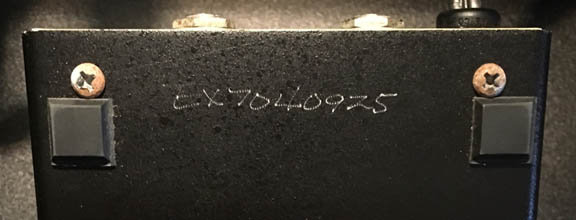
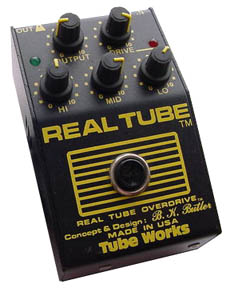

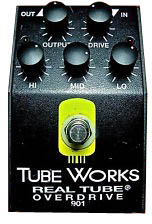
(left to right) The original 1980s Real Tube, RT gold edition, and the 1990s Genz Benz versions made in Taiwan
901 Real Tube (Tube Works and Genz Benz) - 5 knobs, black with yellow graphics. Designed in 1986, but first made in 1987 under Butler's new Tube Works brand. Since Chandler Industries owned the trademark name Tube Driver, Butler named this version the Real Tube. Same op amp and 12AX7 Tube Driver circuit, but with a mid range knob added. Butler considered this version a superior pedal in some ways to his original 4 knob Tube Driver, which I agree with - the added mid range knob makes the tone much more versatile. These can sound slightly harsher and more fuzzy than the later 911 Tube Driver at high gain, depending on the tube used, but at medium to low overdrive settings they can sound identical to the 911. No true bypass.
Special Gold Edition - A tiny number of the US made Real Tubes had a gold anodized finish on the case top. These were made around 1997. Butler made a run of his Tube Driver car amplifiers with a gold anodized sheet metal enclosures. He had some of the gold stock left over and thought it would look cool to make some gold cased Real Tubes. Some 911 Tube drivers were made in gold as well. Butler says he made around 6 for Billy Gibbons, who used to give pedals away. There were probably more than 6 made, as I have seen several for sale, and own two myself. Unfortunately, over time the gold oxidizes and becomes spotted and rusted, but they are still a cool collectible.
The original 1980s Real Tube version was made in Denver, Colorado USA, with several slight graphics changes over the years. The first version was marked on top:
REAL TUBE™
12AX7 TUBE OVERDRIVE
© TUBE WORKS • USA
The graphics on the Real Tube changed slightly in the 1990s through around 1998, still made in the Colorado USA. A small number of these were made with gold tops. They were marked on top:
REAL TUBE™
REAL TUBE OVERDRIVE™
Concept & Design: B. K. Butler
MADE IN USA
TUBE WORKS
A/D Electronics took over Tube Works for Butler in the late 1990s when he was concentrating on the 12v car amp market. Some Real Tube production was made in the USA but most were being made in Taiwan. The ones made around 1998-2000 are marked on top:
REAL TUBE™
REAL TUBE OVERDRIVE™
Concept & Design: B. K. Butler
TUBE WORKS
Genz Benz then bought Tube Works and all Real Tube production was made in Taiwan in the 2000s. The pedals were made with several different pcb's in this period and had different graphics and knobs than the US versions. The country of origin was on the bottom. Some Genz Benz versions have a 9v or 12v power adpator jack on the back rather than an AC power cord. These are easily identified by a solid yellow rectangle around the footswitch. They are marked on top:
TUBE WORKS
REAL TUBE®
OVERDRIVE
901
The Genz Benz Real Tubes are marked on the jack side with:
TUBE WORKS
A Division of
GENZ BENZ
ENCLOSURES
Concept & Design:
B. K. Butler
The Kampo Tube Pedal 901 and Dean Markley Overlord are two clones of this pedal.
902 Real Tube Rack (Tube Works) - A 7 knob rack mount version of the Real Tube, circa 1989.
903 Blue Tube / Real Tube Enhancer (Tube Works and Genz Benz) - 5 knobs, blue with yellow graphics, made in 1987. A smoother, lower gain version of the Real Tube. Same pcb as the 901 Real Tube. The primary difference from the 901 circuit are a few different resistor values in the drive section and a smaller Hi pot value. No true bypass. Early production was made in the USA throughout the 1980s and 1990s. A small number of those were made with gold colored tops and blue printing. After Genz Benz bought Tube Works in the late 1990s a Taiwan made version with different knobs and graphics was produced throughout the 2000s.
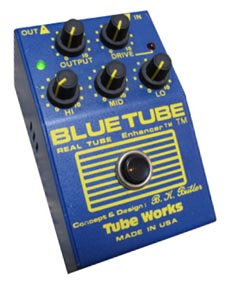
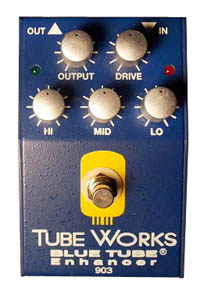
(left to right) The original 1980s Blue Tube made in the USA and the 1990s Genz Benz version made in Taiwan
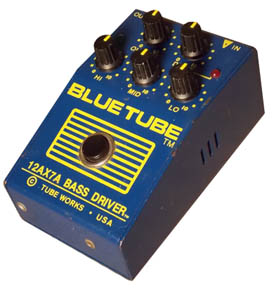
903 Blue Tube / Bass Driver (Tube Works) - Same as the Blue Tube above, but the circuit had a few small changes to make it work better with a Bass guitar. It use the same pcb as the 901 and 903.
904 Blue Tube Rack (Tube Works) - A rack mount version of the Blue Tube made circa 1989.
Dean Markley Overlord (knockoff ) - Dean Markley made this exact knockoff of Butler's Real Tube in the late 1988-1991. According to Butler, the Overlord was copied by DM out of spite after he left his company. In the original Guitar Player magazine ads, the Overlord shown was actually a repainted Real Tube.
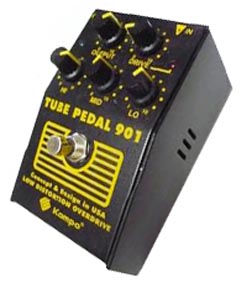
Kampo Tube pedal 901 (knockoff ) - A knockoff of the 901 Real Tube, made in Taiwan. It is housed in a nearly identical enclosure, with the same knobs, and similar graphics as the Tube Works original.
Chandler Tube Driver and owners manual
Tube Driver / Real Tube Overdrive (Chandler Industries knockoff) - 4 knobs, tan with black graphics, made from 1987-89. No BKB Butler markings. Chandler trademarked and owned the names Tube Driver and Real Tube Overdrive, so after Butler stopped making Tube Drivers for Chandler to market and distribute in 1987, they copied his circuit and made this cheaper, simpler version in the USA. The pcb was completely different from the 1986-87 BKB/Chandler version, and had a slightly different circuit than Butler's original, with a slightly different EQ stage. Butler says this circuit is not his authentic design and includes mistakes. I have one and it sounds very different from the 1986-87 BKB/Chandler branded Tube Drivers. Some owners would disagree, but I think they do not sound very good at all and are EQ'd badly compared to the ones Butler made.
Some of these were built with an internal transformer like the original Tube Driver, but most were made with the power transformer on the outside. It was a plug in "wall wart" style transformer, but it was still hard wired to the Tube Driver by a long power cord. Chandler did this to prevent the hum noise associated with the transformer being inside the enclosure in proximity to the circuit, which is a common complaint among Tube Driver owners.

910 Tube Driver (Tube Works) - 3 knobs, tan with black graphics, made around 1993. After Chandler's trademark on the name Tube Driver lapsed in 1993, Butler started making them again under his Tube Works brand. This Tube Driver was a lower cost, entry level version, housed in a smaller enclosure. It had a slightly different voice and a simplified tone stage. Compared to the 4 knob version, it had less volume on tap, sounded more like a fuzz or distortion pedal at high gain, and sounded a little harsher at low gain. Rather than the three-knob Fender style tone section of the Real Tube or four-knob Tube Driver, this version had a single Hi-Lo knob that dialed between bass and treble. At low drive settings it could sound very similar to the 4 knob version through many amplifiers, but obviously the single tone knob limited the possible EQ range so it could be difficult to get a good sound through some amplifiers.
The Behringer VT911 Vintage Tube Overdrive is a cheap sonic clone of the 910 Tube Driver, even though Behringer used 911 in the name. It uses a 12Ax7 tube like the 910. It's not exactly the same sound, but very close.

(left to right) The original 1990s Tube Works 911 Tube Driver made in the USA, the special gold edition, and the later 1990s Genz Benz version made in Taiwan
A 911 Tube Driver circuit from 1994
911 Tube Driver/Real Tube Overdrive (Tube Works and Genz Benz) - Chandler's trademark for the name Tube Driver lapsed in 1993, so B.K. Butler started making the 4 knob Tube Drivers again as a production model under the Tube Works brand around 1993-94. David Gilmour of Pink Floyd was seen using two 1980s Tube Drivers in the studio and on tour in 1993-94, which may have partly influenced the decision to bring these back to the market. I have seen 911s dated from 1994-1998.
These were not exactly the same circuit as the original 1986-87 BKB/Chandler Tube Drivers. The circuit layout and pathways were very similar, but there were several component value changes across the circuit that affect the way it sounds. These sound more like the 5 knob Real Tube circuit, but with a fixed resitor for the mid range instead of a mids knob. The enclosure was the same width as the original 1980s version, but not as long. Standard Tube Works knobs were used, rather than the yellow-capped knobs used on the original 1980s Tube Drivers. The old Tube Works product numbering was continued, so this model was named 911, after the Porsche 911. The 911 model number never appeared on the original pedals, but it was marked on the later Genz Benz Taiwan made version, which was also marked Genz Benz on the jack side of the enclosure.
A tiny number of the US made 911 Tube Drivers had a gold anodized finish on the case top. These were made around 1997. Butler made a run of his Tube Driver car amplifiers with a gold anodized sheet metal enclosure. He had some of the gold stock left over and thought it would look cool to make some gold cased Real Tube and Tube Driver pedals. They are extremely rare and I have only seen four of them. Unfortunately, the gold oxidizes and becomes spotted and rusted, and it seems to get worse over time. I have never seen one in good condition.
The 911 Tube Drivers were made in the USA then production moved to Taiwan after Butler sold Tube Works to Genz Benz around 1998. The Genz Benz versions were made into the 2000s. Genz Benz then discontinued the Tube Works line and ownership changed a few times. The Genz Benz brand ended up being bought by Fender, and Tube Works is no more. Butler reissued the 911 again in 2006, making them by custom oder.
TD-742 Tube Driver Combo Amp (Tube Works) - A 60w combo amp version of the Tube Driver with 12" Eminence speaker, effects loop, clean channel, Tube Drive overdrive channel with 12AX7 tube, reverb, and a single-button footswitch to switch the overdrive on and off. The clean channel is Butler's solid state Mosvalve amp. It sounds like very much like a tube amp with a Fener-like tone. The clean channel tone controls are basically the Real Tube/Tube Driver tone stage, which is basically a Fender tone stage. The built in Tube Driver circuit is similar to the 911 Tube Driver version with a mids knob added.
The amp covering was gray carpet cloth. A tweed covered version was also made in the mid 1990s. Built by Tube Works in Denver, Colorado. I believe TW made them from 1994-1997. When Genz Benz bought Tube Works they continued to make a version of the TD-742.
TD-752 Tube Driver Comb Amp (Tube Works) - Same as the TD-742 combo amp above, but this is a 100w version with additional features. 12" 75w Eminence speaker, effects loop, clean channel, Tube Drive overdrive channel with 12AX7 tube, reverb, a wwitch (not footswitchable) to combine the clean and overdrive channels, a two-button footswitch to switch the reverb on and off and switch from clean to overdrive channels, and a line out jack to power an external speaker cabinet. The clean channel is Butler's solid state Mosvalve amp. It sounds like very much like a tube amp with a Fener-like tone. The clean channel tone controls are basically the Real Tube/Tube Driver tone stage, which is basically a Fender tone stage. The built in Tube overdrive channel includes the same tone controls as the clean channel. The overdrive circuit is similar to the 911 Tube Driver version with a mids knob added.
The footswitch is a two-switch latch type with a 1/4" jack, the same type that Fender uses for amps like the Twin Reverb. The amp covering was gray carpet cloth. Early version had a creat colored faceplate with black text, later version had a black faceplate with yellow text. A tweed covered version was also made in the mid 1990s. Built by Tube Works in Denver, Colorado. I believe TW made them from 1994-1997. When Genz Benz bought Tube Works they continued to make a version of the TD-752.
TD-752-ES Tube Driver Amp Head (Tube Works) - Same as the TD-752 combo amp above, but this is just the amp head only, with speaker out jacks. Came with gray carpet, black tolex, or tweed covering.

301 Rock Tube Drive pick pedal (Tube Works) - 5 knobs, cream triangular enclosure. An unusual Tube Driver variant in the shape of a guitar pick. I'm not sure when these were originally made but I know some were made in the mid 1990s through the 2000s after Genz Benz bought Tube Works. Same pcb as the 901 and 903 Real Tube models, but with some component value changes.
303 Smooth pick pedal (Tube Works) - 5 knobs, triangular enclosure in the shape of a guitar pick. Fitted with a 12AX7 tube. As the name suggests, this a is a smoother, lower gain version of the Real Tube. Nearly the same voice, but half the gain. I'm not sure when these were originally made but I know some were made in the mid 1990s through the 2000s after Genz Benz bought Tube Works. I have one from 1997. Same pcb as the 901 and 903 Real Tube models, but with some component value changes. The circuit appears to be the same as the Tube Works Blue Tube.
913 Tube Driver Rack Mount - A rack mount version of the 911 Tube Driver.
9002 Real Tube 2 Rack Mount Preamp
922 & 9002 Real Tube 2 Rack Mount
Ibanez Tube King TK999US - The 5 knob Japanese made Tube King from Ibanez hit the market around 1994. After finding that the circuit clearly infringed upon his tube overdrive patent, B.K. Butler let Hoshino Gakki (the Ibanez owner) know. Various sources claim Butler/Tube Works sued Ibanez to stop them from making this pedal, but there was never a lawsuit. According Mr Butler, Hoshino sent a rep to meet with him in Denver and resolve the issue over lunch. Hoshino was hoping to get permission to use the circuit for free. Instead Butler struck a deal that would allow Tube Works to have exclusive rights to make the pedal for the US market and Ibanez could manufacture and sell their Japanese made version in Europe and Asia. Tube Works made several thousand of these for the US market throughout the 1990s.
The US version was built by Tube Works in Denver, Colorado (model TK999US). It is marked "Patented: BK Butler" on the circuit board and follows Butler's basic Real Tube circuit, but there were some improvements. Unlike the 911 Tube Driver and Real Tube, the Tube King includes an output buffer so it is immune to most capacitance and loading issues that can plague those other pedals. It runs off a standard 9v DC power jack, not an internal transformer, so noise issues associated with the internal transformer in the Tube Driver and Real Tube have been eliminated. It also had an active EQ instead of the passive EQ in the original Real Tube so it colored the tone a bit differently. I only notice the difference at low drive settings. At high drive settings it sounds basically identical to the Real Tube or Tube Driver. When it was first released it had no vent slots on the sides of the enclosure, then they were added about a year later. In the late 1990s the case color changed to silver. There were at least 4 revisions of this circuit. 9v DC seems to have been the standard power requirement, but I have seen one that ran off 12v. DC.
The Japanese model was made by Maxon for Hoshino/Ibanez in 1994, a year before the US version. Although it incorporated parts of Butler's patent, it is a very different circuit than the US made model. It had a noise gate knob on the back, one 12AX7 tube, and four JRC4558 OpAmp chips. There was a version made under each brand - Ibanez model TK999 and Maxon model ROD880 - same enclosure and circuit but different graphics. Ibanez later made a TK999HT version, but that was a different, high powered tube circuit, rather than Butler's starved plate tube design used in the Real Tube and Tube Driver.
A 911 Tube Driver reissue made in 2007 on left and a 2008 model with the optional bias pot modification added to the back
911 Tube Driver (BK Butler reissue) - 4 knobs, tan with black graphics, first made in 2005. A hand made reissue of Butler's original 911 Tube Driver (Tube Works) design from the 1990s. This is not a reissue of the original 1980s BKB/Chandler Tube Driver versions. The circuit layout and pathways were very similar to the 1980s circuits, but there were several component value changes across the circuit that affect the way it sounds. The 911 sound range is much broader and voiced slightly different than the 1980s circuits. Overall, the sound and tone range is more like the 5 knob Real Tube circuit, minus the mids knob, but similar tones can be dialed in to match the older 1980s Tube Drivers. Butler had new tooling made for the knobs that was very similar to the knobs used his old 1986/87 Tube Drivers.
These are made by custom order through Butler Audio. The enclosure is identical to the 1990s Tube Works version, which was the same width as the original 1980s version, but not as long. Butler made several of these for David Gilmour and Eric Johnson, among other well known guitarists. He shipped some of these (by request) with older NOS (new old stock) YUGO 12AX7 tubes (made by Ei in Yugoslavia before they shut down), the same type that were were shipped with the older Tube Works pedals. The tubes were custom marked with a Real Tube logo. He stated these were the tubes Eric Johnson and David Gilmour preferred, although it is not clear if either actually used this tube. The standard tube the reissues ship with is an unbranded 12AX7/ECC83 tube simply marked with a hand written "BK". Butler said these are Golden Dragon brand, low noise, hi-fi audio tubes. They have a shorter plate than the Ei Yugo tubes.
In 2008 Butler made the tube bias pot a custom option again, adding the knob to the back side of the unit. This is the same custom option offered since the 1980s. It allows the gain of the tube to be altered by adjusting the voltage on the cathodes of the tube, simulating the effect of using higher or lower gain tubes. If you want to read more about BK Butler and the Tube Driver, there is a good interview over on the Tone from Heaven website.
The 911 runs off an internal 12v AC transformer. The current draw is approximately 30mA. At some point around 2008 Butler changed the transformers in his TDs to a custom toroidal type, primaries 120VAC, secondaries 12VAC at 200mA. Those were much less noisy that the original laminated core transformers he used in the past and helped eliminate 50-60Hz hum.. I have heard that some people who complained about noise issues sent thier older TDs back to Butler and he replaced the old transformer with toroidal type. Butler's stock Tube Drivers run 110-120VAC but on request he would change to a transformer that works with 220-240VAC 50-60Hz for the European market, although they shipped with a standard 3 prong USA plug. At some point he started using a toroid transformer that runs from 120-240VAC for the European version.
These Tube Drivers have an eight digit serial number engraved on the bottom. The first two digits are the year made, next two digits are the month, next two digits are the day, and last two digits are the number in the batch. so serial number 06071709 would be:
06 = 2006
0717 = July 17th
09 = 9th made in the batch
.
